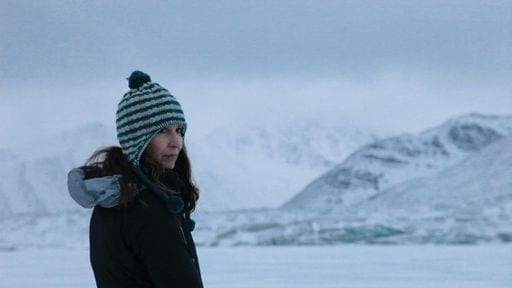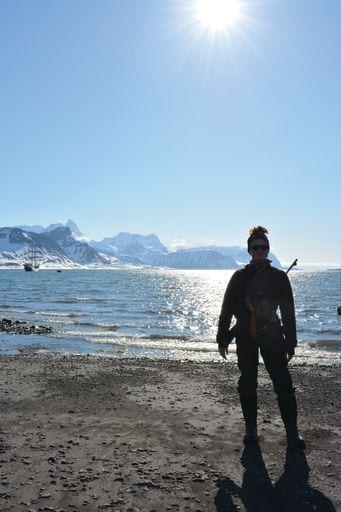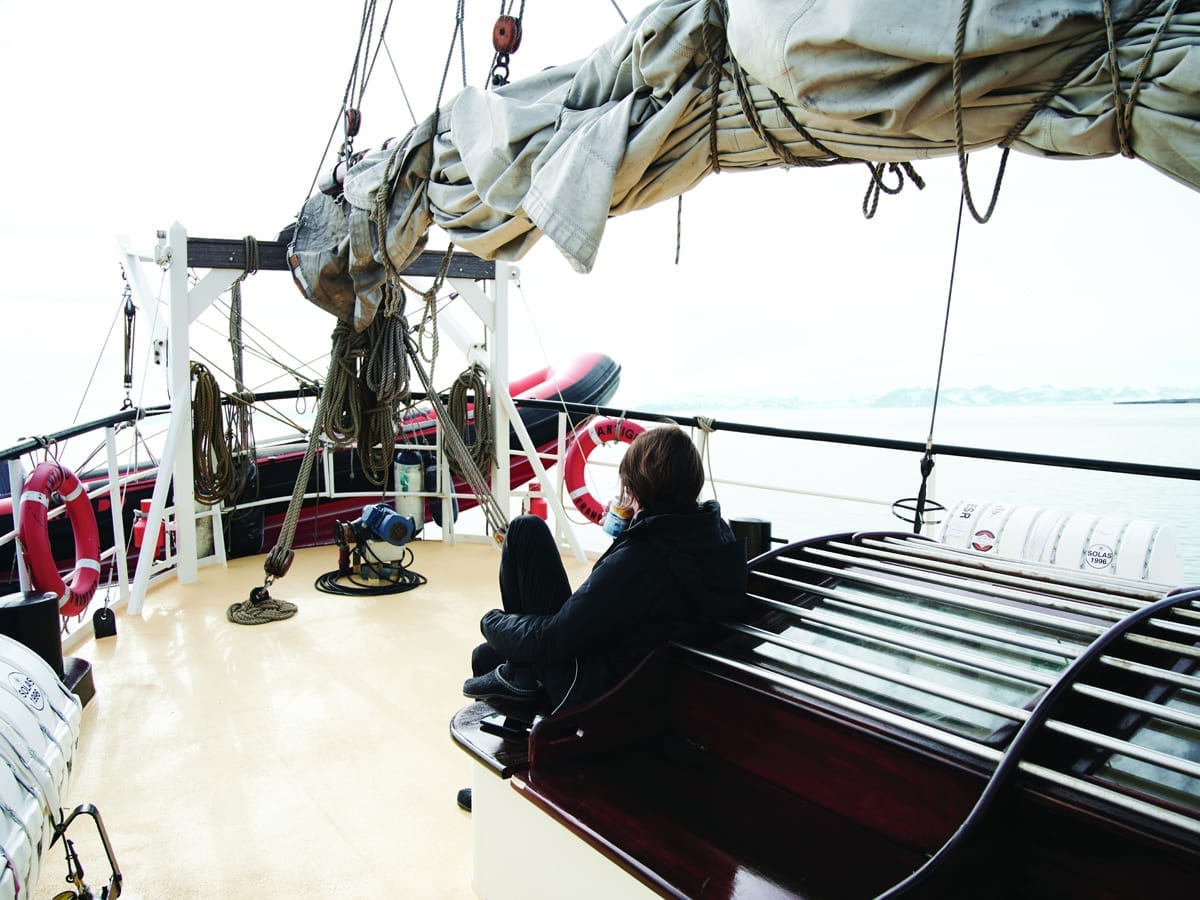Expansive seas under perpetual daylight. An incessant chattering of cracking ice. The thunder of calving icebergs. Ceaseless winds of penetrating cold. An endless resource for inspiration and contemplation.
With today’s access to illimitable information and global connections, it is unsurprising that artists are seldom defined by a single discipline. In the same vein, collaboration is at the forefront of artistic ingenuity by way of artist collectives, guilds and artist-in-residence programs. A.I.R. programs, in essence, offer space and time for artists to research, experiment and create. These programs are located all over the globe and are wildly diverse in their approach, with the majority focused inside the artistic domain. Some afford artists unadulterated freedom, where they can spend the time as they desire, having no conditions to produce a final product. Others are more structured, requiring focus on a specific outcome, whether that be definitive research, work for an upcoming exhibition or interaction with the local community.
One such program that is spearheading interdisciplinary collaboration is an annual expeditionary residency that brings together international creatives of all fields—visual artists, scientists, educators, musicians and writers—who collectively explore the High-Arctic Svalbard Archipelago and Arctic Ocean aboard a barquentine sailing vessel for three weeks. The Arctic Circle program, founded in 2009 by current director, Aaron O’Connor, is a rare breed in the realm of residencies whose participants experience extreme conditions while having the opportunity to collaborate across platforms. A panel of jurors reviews and selects approximately 60 participants a year, who are then divided between only two expeditions, one in summer and one in autumn. There are no stipulations to what an applicant can or cannot propose for their residency project.

Janet Biggs, still from the video In the Cold Edge, 2010. Single-channel, high definition video with sound. Running time 05:29. Biggs was a participant of the inaugural residency expedition, autumn 2009.
Even for the ultimate worldly traveler, it is difficult to imagine the unforgiving conditions of an arctic climate. For seventeen days, the ship sails the waters of the international territory of Svalbard, an archipelago that is midway between mainland Norway and the North Pole. The cluster of islands is known for its rugged, isolated terrain of glaciers and vast, frozen expanse. Explorers on the summer expedition observe a relentless 24 hours of daylight, while the autumn trip endures frigid temperatures as low as -4° Fahrenheit. No two expeditions are the same because the destinations explored within the territory entirely depend on the individual needs of the proposed projects. Expansive seas under perpetual daylight. An incessant chattering of cracking ice. The thunder of calving icebergs. Ceaseless winds of penetrating cold. An endless resource for inspiration and contemplation.
Each artist arrives with their own goals for the trip, but those intentions are at the mercy of the environment and their boat mates. Brooke Holm, who was on the latest summer 2019 expedition, is a photographic artist who studies the unique and complex bonds humans form with the natural environment, exploring ideas of our impact on the world. “I went with clear ideas and concepts in my head about what I wanted to capture, and how it would look visually—but as with any landscape work, you are at the mercy of the elements of nature. You can’t control it. You need to let it guide you, work with it and not force your own ideas on it,” says Holm.
Among the other creatives in Holm’s group, there were photographers, painters, sculptors, historians, book authors, poets, educators and, of course, several were less-defined and traversed fields. There was a total of twenty-one women, in contrast to nine men, all bringing varying viewpoints from the United States, Switzerland, France, Italy, Ireland, England, Germany and Australia. Each came to share space, time and ideas with other field experts in the hopes of breaking disciplinary traditions and discovering new approaches to the issues of our time. A great number of the participants shared a strong interest in the intersection between art and science, which was a driving force behind the program’s founding.
Mia Mulvey, a visual artist whose work addresses the recording of time, climate change and our relationship to remote landscapes, was among this group. Mulvey explained that the work she is creating could not be done without participating in this residency. “The unique and varied role of glacial and sea ice within this landscape as a marker of climate change and ecological time was compelling to me from both a scientific and a poetic perspective,” tells Mulvey. To collect data, she would immerse herself into freezing lagoons and examine forms of ice using a process of 3-D scanning and infrared photography, as well as through sound and video documentation.
The changing environment is important to capture for both Holm and Mulvey, yet their means of gathering research vastly differ. That is what makes The Arctic Circle program so uniqueand effective—it brings together a diverse array of inquisitive minds that can learn from one another. Besides, this collective learning experience is quite inevitable for the participants who must share tight quarters. Holm recalls, “It felt like a social experiment to throw 30 people onto a ship in the northernmost part of the world with no internet, no phone service, no outside contact with the world, 24 hours of sunlight a day AND with the most dangerous predators in the world—just to see what would happen . . . We hardly slept, we worked on our projects, we hiked, swam, shared our work, shared our personal lives, we laughed, we cried, we collaborated . . . It felt like one really, really long day.” Strong and everlasting bonds were formed among participants, who have continued to share their knowledge and collaborate upon returning to land.
Aboard the tall ship, Antigua, artists bunked together in two-berth cabins and were afforded a workspace, common areas and room for creativity. Holm describes the outside deck as an “open playground” for cyanotypes, paintings, stick and poke tattoos, collecting plastic trash, yoga, hammock laying, hoisting the sails, climbing the mast, rope tying tutorials and more. A team of four guides leads the expedition, ensuring everyone is prepared prior to leaving port and is responsible for the group’s safety on and off the ship. Almost daily, these guides, armed with rifles, would take the passengers to land by a small, inflatable boat called a zodiac. No one is permitted to venture on land without the protection of a guide, and a simple rule is to take nothing and leave no trace behind. If they are lucky, participants may catch sight of polarbears, arctic foxes and Svalbard reindeer.
Janet Biggs, who was part of the inaugural residency in 2009, recalled seeing a group of polar bears feeding on a whale carcass: “They slid around on their bellies, with legs stretched out behind, and playfully boxed at each other. A couple of bears wrestled and rolled down the snow-covered hill. It was an amazing sight. Our guide said he has never seen so many bears in one place in the twenty years he has been working in the Arctic. Nearby, an Arctic fox waited a good distance away, hoping the bears would leave some of the whale for them.” Biggs is an interdisciplinary artist, known for her work in video, photography and performance, who investigates individuals in extreme landscapes or situations and often navigates the territory between art and science.
When you think about a voyage to one of the most remote, extreme places on earth, who do you imagine is leading the expedition? The Arctic Circle team of guides is entirely comprised of women, some of whom are artists and past participants themselves. As Mulvey tells, “They shared their knowledge, kept us safe and were examples of strong, independent women. I realized this was an important factor for me in contrast to the backdrop of male dominated history of arctic exploration.” These spirited women, both guides and participants, prioritize seeking answers over comfort.
As magnificent as the experience may seem, the lingering sight that brings attention to the most pressing issue is that of the rapidly melting landscape. This is a scene that was described repeatedly by each artist. “Seeing a glacier calve for the first time changed me for the rest of my life. To see a natural process sped up by climate change and to know I added to the change even by flying that far in a plane to see it, really impacted my whole way of thinking about the world,” says Regan Rosburg, an artist, curator and educator who was on the 2019 summer expedition. She explains, “One cannot be in that environment (Svalbard) and not be right up against the climate change reality. Everything there is literally melting, shifting, surging, gushing, growing and changing.”

Today, the Arctic Circle expeditions are led by an all-female team of guides, often armed with rifles to protect participants while exploring on land. PHOTOGRAPH BY REGAN ROSBURG
Questions of such magnitude are best investigated in incubators like The Arctic Circle, where creative minds across all fields share knowledge through unrestrained exploration. Not only was the studio practice of each artist impacted, but many described the experience as life-changing. “This place is so profoundly significant to me that it has its own life within my practice. While I was there, I changed on a personal level, learned more about myself and my work, about others and our planet.” Holm continues, “Art has the power to change the world and society, so in my opinion, an institution or organization that is actively pursuing the imperative role of supporting artists is aiding in the progression towards positive change.”
For more information, go to thearcticcircle.org.
by Hannah Shepard
ELYSIAN Arts & Culture Editor

